Content
- The role of potassium in a woman's body
- Potassium levels in the blood (after 40-50-60 years)
- Why is excess potassium dangerous?
- Hyperkalemia symptoms
- Causes
- Diagnosis of an excess of potassium
- Treatment
- Drug therapy
- Enterosorbents
- Diuretics
- Hormone therapy
- Food
- Allowed Products
- Prohibited foods
- Hyperkalemia video
Excess potassium in the body or hyperkalemia - a pathology that is equally common in men and women. Symptoms of the disease indicate kidney problems. Pathology requires drug treatment. Experts also recommend sticking to a diet that will speed up the process of removing potassium from the body.
The role of potassium in a woman's body
An excess of potassium in the body (symptoms in women do not appear immediately) can provoke the development of serious diseases. A person should receive at least 4.5 g of the mineral daily. The most suitable sources of potassium are foods. If a woman suffers from acute or chronic renal failure, then the daily rate is reduced to 2.5 mg.
It is also strictly forbidden to independently exceed the norm for people suffering from heart disease or diabetes mellitus. In healthy people, the potassium content should vary between 4-5 mmol / L. The mineral plays an important role in the vital processes of the body. It ensures the normal functioning of the central nervous system, is responsible for the timely contraction of muscle fibers and helps maintain water and electrolyte balance.
Also, thanks to potassium, the body maintains a normal sugar level and blood pressure does not jump. The human body is not able to synthesize the mineral on its own, therefore it is important to monitor the quality and quantity of food consumed, which contains potassium. If a person does not receive a mineral, then the risk of developing hypokalemia is high.
The condition is extremely life-threatening. If the concentration of the mineral is less than 2.5 mmol / L, then the risk of stroke, heart attack, paralysis and suffocation is high.
Potassium levels in the blood (after 40-50-60 years)
Usually, blood for potassium must be donated in case of violations of the cardiovascular system. A cardiologist or therapist will write a referral for analysis if a woman has persistent high blood pressure. Also, the reason for the appointment of a biochemical blood test is a violation of the functional activity of the adrenal glands. Potassium norm in women, table by age:
| Age | Indicators |
| 30-40 years old | 3.3-3.7 mmol / l |
| 40-50 years old | 3.7-3.9 mmol / l |
| 50-60 years old | 4.1-4.5 mmol |
| Over 60 years old | 4.6-5.0 mmol / l |
Depending on the concentration of potassium in the blood, there are several main degrees of the disease:
- severe - more than 7.1 mmol / l;
- moderate severity - from 6 to 6.9 mmol / l;
- light - from 5.2 to 5.9 mmol / l.
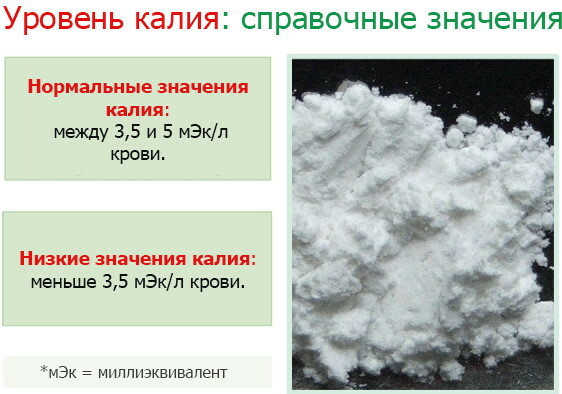
If the level of potassium in the blood exceeded the norm by 2 or more times, then the patient is diagnosed with a form of hyperkalemia, which is life-threatening.
Why is excess potassium dangerous?
Excess potassium in the body (symptoms in women are almost the same as in men) negatively affects the functioning of internal organs and systems. Pathology is considered a life-threatening condition. In the absence of adequate treatment, tachycardia can turn into atrioventricular block or asystole (sudden cardiac arrest). Against the background of an excess of potassium, the respiratory muscles will stop weaker, so there is a high risk of respiratory arrest or respiratory failure.
With hyperkalemia, the organs of the digestive tract also work intermittently. If the disease is not treated on time, then dynamic intestinal obstruction may develop. Pathology is characterized by the formation of dense fecal plugs that impede the movement of contents through the intestines. The condition is accompanied by severe pain, vomiting, bouts of nausea, increased gas production and constipation. At the peak of a pain attack, a person's heart may stop.
Atrioventricular (atrioventricular block) is characterized by the cessation of communication between the ventricles and the atria. The most dangerous condition provoked by hyperkalemia is considered asystole. The patient's heart suddenly stops and stops breathing. The brain gradually dies off.
The condition is considered potentially reversible. It is important to restore cardiac activity in a few seconds.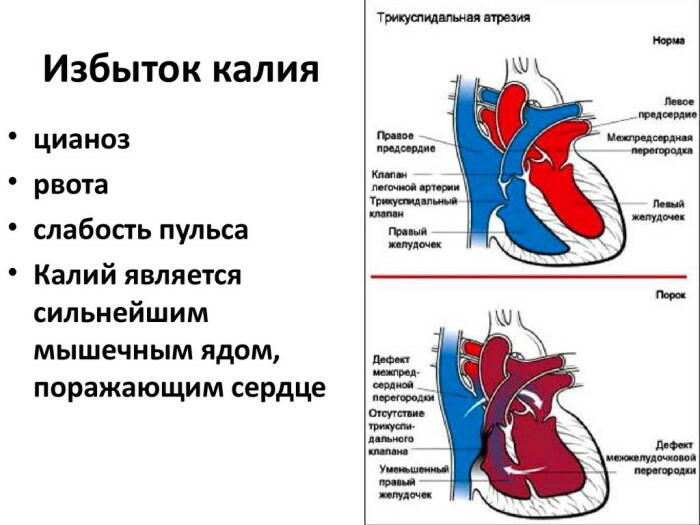
The development of asystole may be indicated by the simultaneous appearance of the following symptoms:
- vomit;
- nausea;
- headache;
- drowsiness;
- general weakness;
- tachycardia;
- panic;
- anxiety;
- breathing disorder;
- pain in the sternum and heart;
- loss of consciousness.
An asystole attack usually occurs suddenly. The person faints and stops breathing. First of all, blood circulation is disturbed, the pulse cannot be felt.
Hyperkalemia symptoms
The disease can often be asymptomatic at the initial stage. Light ailments are attributed to fatigue or vitamin deficiency. The characteristic symptoms of hyperkalemia appear most often with a moderate degree of the disease.
An excess of potassium in the body (symptoms in women are listed below in the list) leads to health problems:
- labored breathing;
- tiredness, weakness;
- muscle and joint pain;
- paresthesia;
- drowsiness.

Most of all, with hyperkalemia, the heart suffers.
The following signs indicate a violation of the functional activity of an organ:
- slow or fast heart rate;
- sternum pain;
- tingling on the left with a deep breath.
Also, the development of hypokalemia may indicate dyspeptic disorders. With an excess of potassium, muscle atony appears, so a person suffers from constipation. He has pain after eating and a heaviness in the stomach.
Causes
There are several main reasons for the development of hyperkalemia. An excess of potassium in the body can occur against the background of prolonged use of drugs that contain a trace element.
For example, Magnesium-Potassium Forte, Magnerot, Kudesan, Doppelherz Aktiv, Asparkam, Panangin. Most medicines that help restore the functional activity of the cardiovascular system also contain trace elements. Potassium levels can be affected by taking muscle relaxants and beta-blockers.
If a person suffers from diabetes mellitus, then against the background of pathology, metabolic acidosis often develops, provoking a violation of the processes of removing potassium from cells. Most often, the disease develops against the background of chronic and acute renal failure.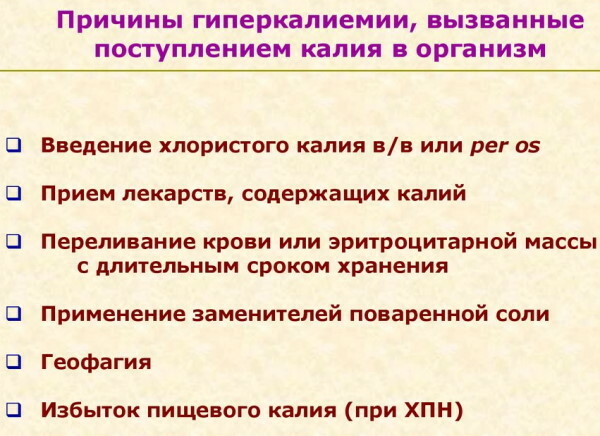
Systematic consumption of foods containing large amounts of potassium (chocolate, prunes, dried apricots) can lead to hyperkalemia. Also, you can not uncontrollably take biologically active supplements containing micro- and macroelements.
Diagnosis of an excess of potassium
Diagnosis of hyperkalemia takes place in several stages. First of all, you need to exclude a false form of pathology. The disease can be supervised by a nephrologist, therapist or cardiologist. Before the appointment of a particular examination, a specialist examines the patient, listens to his complaints and collects an anamnesis.
The patient must inform the doctor about all dietary supplements and drugs taken in the last 2-3 months. During the examination, the specialist detects tachypnea, suppression or weakening of reflexes.
Diagnostic measures to quickly identify hyperkalemia:
- Electrocardiography. ECG is considered the most important instrumental method for detecting pathology. It detects QRS widening, T-wave clarity and length, and sinus bradycardia. Also, the ECG helps to note the expansion, flattening of the PQ or shortening of the QT.
-
Assessment of renal functional activity. To do this, the doctor must determine the weight and amount of biological fluid, the concentration of urea and creatinine. It is necessary to determine the filtration rate, osmolarity of serum and urine. Also, the specialist determines the concentration of potassium in the biological fluid.
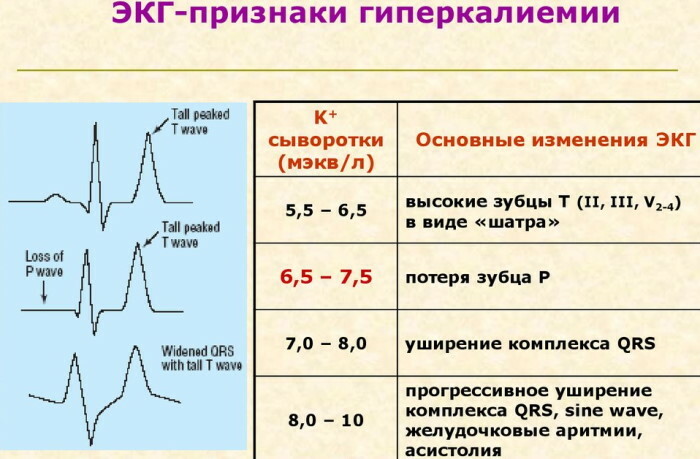
Also, the patient must donate blood and urine for analysis. The hemogram allows you to determine the number of platelets, erythrocytes, hemoglobin. Biochemical analysis reveals the level of sodium, creatine phosphate and glucose. If a patient suspects adrenal insufficiency, an ACT test should be performed.
Also, with suspicion of hyperkalemia, CBS of the blood is prescribed (assessment of the acid-base state). Take blood from a finger or artery.
Treatment
An excess of potassium in the body (symptoms in women may be mild) provokes the development of diseases of the heart and blood vessels. Self-treatment of hyperkalemia at home is rare. Usually, patients are admitted to a hospital. If a severe degree of hyperkalemia has been diagnosed, then the patient is transferred to the intensive care unit or intensive care unit.
First of all, it is necessary to stop taking medications that accelerate the accumulation of potassium in the body (non-steroidal anti-inflammatory drugs, diuretics). If the patient is admitted with advanced hyperkalemia, then he is connected to a ventilator.
There are several main directions for the treatment of pathology:
- Strengthening cell membranes. If the patient's condition is serious, then calcium salts will help restore the work of the cardiovascular system. The drugs have an antagonistic effect, stabilize the functional activity of the myocardium. For intravenous administration, a calcium gluconate solution is usually used.
- Movement of a trace element into cells. The patient is administered glucose with insulin or Salbutamol (beta-adrenergic receptor antagonist). It is also necessary to introduce sodium bicarbonate to relieve acidosis.
-
Drug therapy. The drugs help to quickly remove calcium ions from the body. Most often, the patient is prescribed diuretics, enterosorbents and hormonal medications. The reception scheme is selected individually.
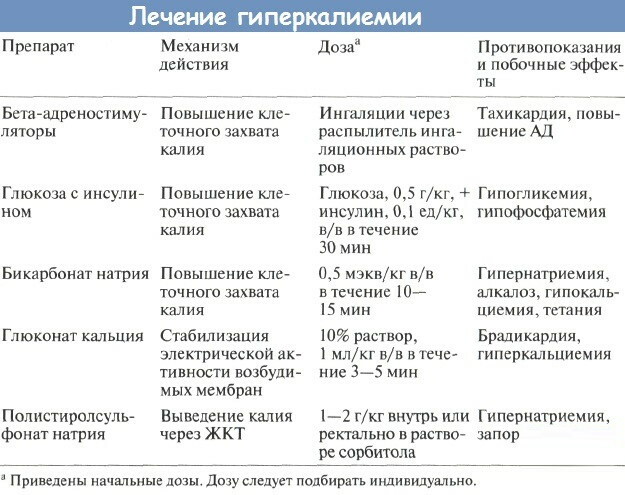
If the patient's life is in danger, then calcium ions are removed from the body on an emergency basis. For this, hemodialysis is performed using a special solution.
Drug therapy
The use of drugs is mandatory for severe hyperkalemia. To stabilize the patient's condition and restore the functional activity of the myocardium, it is necessary to inject a 10% solution of calcium gluconate (10 ml, slowly, jet) into the patient's vein. To assess the degree of work of the heart, the patient is given an ECG. If there are no changes on the cardiogram, then it is necessary to re-inject a solution of calcium gluconate into the vein in the same dose.
Insulin will help temporarily reduce blood potassium levels. It is administered subcutaneously at a dose of 10-20 units. In the absence of hypoglycemia, glucose can be administered to the patient (no more than 30-40 g once).
Enterosorbents
Drugs in this category are prescribed for moderate to severe hyperkalemia. The active ingredients in the composition of medicines are responsible for the absorption of toxins (including potassium salts) and neutralization of their aggressive action.
The following funds may be included in the drug therapy:
- Carbopect. The drug is marketed in capsule form. The active ingredient is activated carbon. A broad-spectrum drug can be used for hyperkalemia. Potassium salts absorbed by charcoal will leave the body after 24 hours. The medication is well tolerated by patients, so side effects are rare. Carbopect is not prescribed for people suffering from ulcers and intestinal atony. The daily rate of the drug is no more than 8 capsules.
-
Polyfan. Dosage form - granules for solution preparation. The composition of the drug contains hydrolytic lignin, which acts as an active substance. Enterosorbent is responsible for removing excess potassium from the body. The remedy is contraindicated for people suffering from gastritis, ulcers and intestinal atony. The medicine must be diluted with water (1 tbsp. l. 50-70 ml of warm water) and drink.
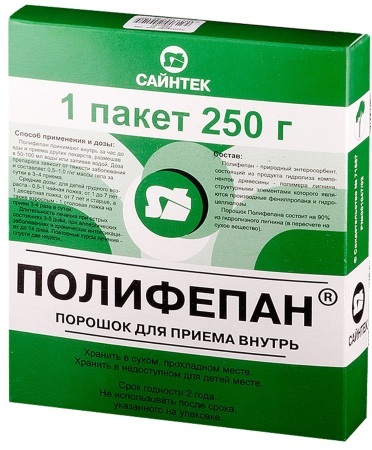
- Enterodesis. The drug is marketed in the form of a powder for solution preparation. The active ingredient is polyvinylpyrrolidone. The mechanism of action of the substance is standard - it binds potassium salts and accelerates the process of their elimination from the body. The drug is not prescribed for intestinal atony and ulcerative lesions of the digestive tract. The daily rate is no more than 30 g of powder, which is equivalent to 300 ml of the finished solution.
If the therapeutic norm is independently exceeded by 3 or more times, the risk of developing characteristic symptoms of an overdose is high.
Diuretics
Medicines in this category stimulate the urinary system. The drugs are relatively safe, their use is allowed for heart and kidney failure. Loopbacks start to act pretty quickly. After 10-20 minutes. the maximum concentration of active components is found in the blood. The therapeutic effect lasts for 5-7 hours.
The following drugs can be prescribed as part of drug therapy for hyperkalemia:
- Pyrethanides. The drug helps to accelerate the excretion of potassium from the body. The drug is characterized by a hypotensive effect. Pyrethanide can be used for hyperkalemia. The drug is marketed in the form of a solution for intramuscular administration or oral administration. The daily allowance should not exceed 12 mg. It can be divided into 2-3 applications. The medication is not prescribed for chronic and acute renal failure, hypokalemia, hyponatremia and hypovolemia.
- Torasemide. A loop diuretic has a pronounced diuretic effect. They are marketed in the form of tablets. You can not prescribe the drug to people suffering from arrhythmia, anuria, hyponatremia, hypokalemia, hypovolemia. Children's age, the period of gestation and breastfeeding can also be considered an absolute restriction to use. The therapeutic dose of the drug is 3-5 g.
-
Furosemide. The drug comes on sale in the form of tablets. The active ingredient is the substance of the same name. The medicine has a pronounced diuretic effect, contributing to a more rapid excretion of potassium ions from the body. You can not take the medication for people suffering from gout, hypokalemia, hyponatremia, glomerulonephritis, pancreatitis, systemic lupus erythematosus. Pregnant and breastfeeding women, children and the elderly should be taken with caution. The daily dose of the drug is 1200-1500 mg.

It is not recommended to adhere to the treatment regimens prescribed in the instructions. The dosage regimen should be selected individually.
Hormone therapy
Hormonal drugs may be included in drug therapy.
These include:
- Hydrocortisone. It is marketed in pill form. The composition contains cortisone acetate (no more than 25 mg). Natural glucocorticosteroid has anti-inflammatory, anti-toxic, anti-shock and anti-exudative effects. With hyperkalemia, which develops against the background of adrenal insufficiency, the medication accelerates the process of excretion of potassium ions. The daily rate for adult patients is no more than 25 mg. Contraindications are diabetes mellitus, osteoporosis, childhood, the period of gestation and breastfeeding.
- Fludrocortisone. The drug is marketed in pill form. The active ingredient is hydrocortisone acetate. The drug can be included in the drug therapy for severe hypokalemia, which developed against the background of secondary adrenal insufficiency. Contraindications are fungal infections and hypersensitivity. The daily rate is no more than 30 mg.
The above drugs can only be taken as directed by a doctor. Self-selection of medicines is strictly prohibited.
Food
An excess of potassium in a woman's body can occur with improper nutrition or against the background of dehydration. Symptoms usually indicate abnormalities in the cardiovascular and endocrine systems.
Patients with moderate to severe hyperkalemia require a diet based on the following principles:
- partial rejection of foods rich in potassium (vegetables, dried fruits);
- partial refusal from bakery, pasta, cereals, dairy products;
- complete rejection of alcohol and chocolate, salty, spicy, fatty foods, strong coffee and tea.
It is better to undersalt the dishes. It is allowed to cook vegetarian soups from vegetables and cereals (borscht, cabbage soup, cold and hot beetroot soup). Average serving weight is 250-300 g. Rye, wheat bread should be completely excluded from the diet. It is replaced with salt-free and protein-free. The daily norm is no more than 300 g.
It is necessary to completely exclude fatty fish and meat from the diet. Vegetables can be stewed, sautéed or eaten fresh as an independent dish. Fruits and berries should preferably be lightly heat treated. Under the influence of temperatures, the concentration of potassium in them decreases.
Allowed Products
The basis of the diet is made up of fresh vegetables, fruits, some cereals, low-fat varieties of fish and meat.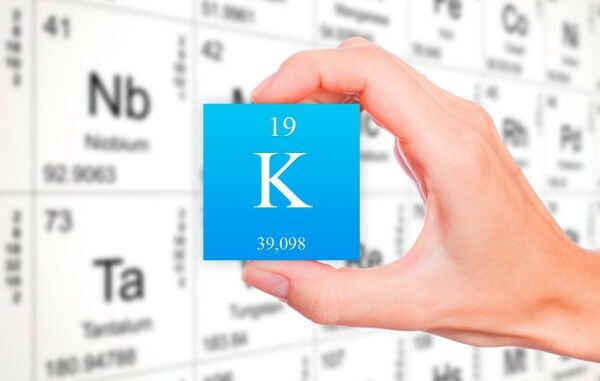
The list of approved products includes:
- vegetables - pumpkin, tomatoes, beets, carrots, potatoes, cauliflower, zucchini or zucchini;
- berries and fruits - strawberries, apples, figs, melon, watermelon;
- cereals - unground, white rice;
- sweets - marshmallow, fudge candies, preserves;
- spices, seasonings - dried herbs, milk, sour cream sauce, honey, cinnamon, cumin;
- dairy products - yogurt, yogurt, whey, low-fat sour cream:
- meat - fillet of turkey, chicken, rabbit, veal, lean beef;
- fish - cod, pollock, hake, pike perch, pike.
During the day, you can drink unlimited amounts of non-carbonated mineral water, green tea, carrot-apple or apricot juice.
Prohibited foods
During the diet, experts recommend completely abandoning fatty meat and fish broths. The use of highly carbonated and alcoholic beverages is strictly prohibited. Fast food, ready-made marinades, sauces, margarine, sausages, canned food are prohibited.
All foods containing a large amount of potassium must be completely discarded:
- mushrooms;
- soy;
- lentils;
- syrup;
- artichokes;
- spinach;
- rhubarb;
- nuts;
- dried fruits;
- chocolate;
- sesame;
- sea fish;
- mutton;
- pork;
- horsemeat;
- eggs;
- cottage cheese;
- legumes.
Soups and cereals are preferably cooked in water. Store-bought seasonings can be replaced with fresh herbs.
Excess calcium in the body in women, men and children can lead to the development of heart failure. If the characteristic symptoms of hyperkalemia appear, you should immediately seek the advice of your doctor. It is strictly forbidden to independently select the treatment.
Hyperkalemia video
What is hyperkalemia. Hyperkalemia symptoms:



